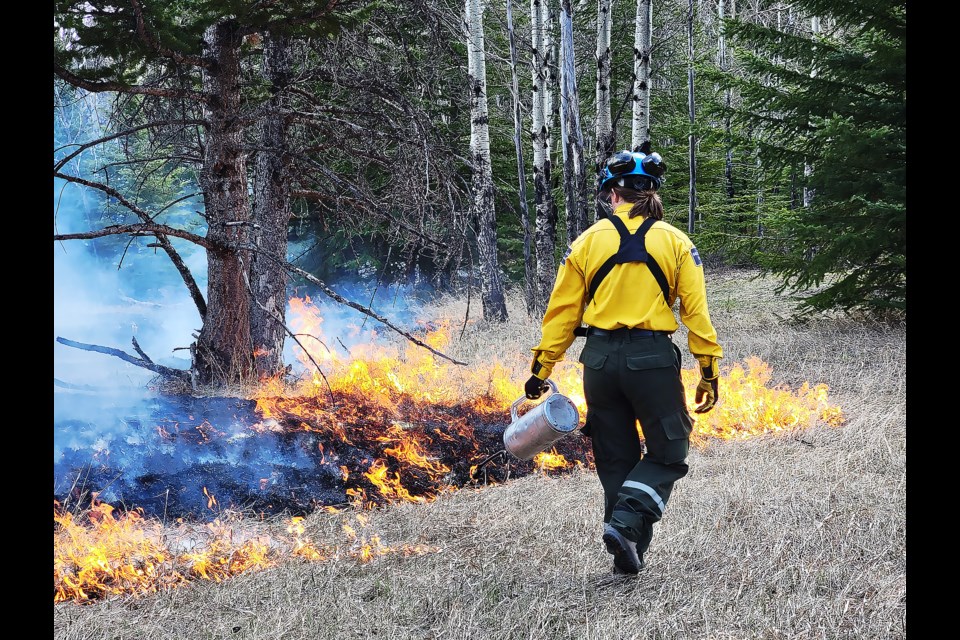BANFF, Alta – Prescribed fires take years of in-depth planning and Parks Canada has a history of safe and successful burns in Banff National Park.
The federal agency has a series of prescribed fires on the books this year, including a large burn across a 4,460-hectare area on the Fairholme bench between the Johnson Lake area and the national park’s east gate down to the Trans-Canada Highway.
Fire crews also just finished off a burn at the base of Cascade Mountain near the Banff townsite earlier this month.
“People don’t see the planning that goes into these things,” said Jane Park, fire and vegetation specialist for Banff National Park.
“A lot of these burns are years of planning ahead of when we actually light the match, and once you light the match, that’s actually the part that is the most planned out and we’re most prepared for.”
The Fairholme bench was previously burned in 2003, which significantly reduced dense forest following more than a century of fire suppression in the national park.
A minor burn may get off the ground there this spring, depending on weather conditions, but the main prescribed fire is set for the fall. The goal is to reduce lodgepole pine regrowth, restore montane grasslands and open up forests to a more historical landscape.
Park said this will improve habitat for wildlife, such as grizzly bears, wolves and elk.
She said it will also create an important fuel break protecting local communities such as Harvie Heights and Canmore in the event of a wildfire.
“The effects of climate change on the wildfire season are already starting to be seen across the world,” Park said.
“This type of landscape level fire management is really required to set our landscapes to be more resilient to those impacts of climate change, both for the ecosystem but also for the people who live in this area.”
Preparation for the Fairholme II fire also requires planning to protect important natural and cultural treasures, including a cabin built by the ‘Hermit of Inglismaldie’ in 1910. Billy Carver lived there alone for 27 years.
There is also work needed to protect a stand of ancient Douglas fir trees, including a 700-year-old-plus tree believed to be the oldest living Douglas fir in Alberta.
They’ve flourished on the benchlands because they have specially adapted to withstand low intensity fires historically common to montane ecosystems.
“Most of the trees we protected back then are still alive. I don’t know exactly if that specific one is, but a lot of the trees in that stand that are of similar age are still kicking,” said Park.
“Some of the objectives are to restore that Douglas fir grassland, so we’ll be doing work to protect some of those really big old trees in that area prior to doing the prescribed fire.”
Other important sites within or adjacent to the burn, such as evidence of pre-settlement Indigenous people or post-settlement associated with the coal mines, will also be protected.
“They are protected throughout the prescribed fire, whether we put sprinklers on them or brush around them or a combination of both,” Park said.
In early May, national park fire crews did a small 124-hectare burn at the base of Cascade Mountain north of the Trans-Canada Highway – the first front country prescribed fire in Banff since the Sawback was burned in 2014.
The goal of the burn was to reduce conifer tree growth in meadows, stimulate the growth of deciduous trees and grasses, and restore habitat for a host of wildlife, including elk which use this area as important over-winter habitat.
Park said another goal was to help decrease the wildfire hazard to the nearby Banff townsite.
“It went really well and we achieved all our objectives,” she said.
During a burn, firefighters have firefighting equipment in place to contain the fire within pre-determined boundaries. It is not uncommon for helicopters to monitor the fire’s progress, with additional aircraft, crews and equipment on standby to assist with control if required.
Despite endless posts on social media sites about the prescribed fire getting out of control, Park said this was simply not the case.
She said the Town of Banff had emergency vehicles on the side of the road to make sure the wooden posts of the wildlife exclusion fence on the Trans-Canada Highway didn’t burn.
“The wildlife fence is a very important piece of infrastructure, so they were watering down the fence posts,” she said.
There were two helicopters on site – one for aerial ignition of the fire and one with a bucket for dumping water when needed.
“We always have what we call holding and containment resources on just to put water down ahead of where we’re burning so we can keep it within the unit,” Park said.
The prescribed fire took place when the right weather window opened up to do so.
“We just decided to push the bottom on that because we’re always looking to burn with opportunities for incoming precipitation on the other end,” Park said.
“That obviously helps us with mop up afterwards, and by the next morning there was snow on the ground, so that is always a great thing.”
Beyond the two front country prescribed fires this year, the rest are planned for the backcountry of Banff National Park.
They include the Dormer Valley, Wigmore Meadows, Elk Pass Meadows and the remote Alexandra valley in the northern end of the park, an area that hasn’t seen fire in 275 years.




